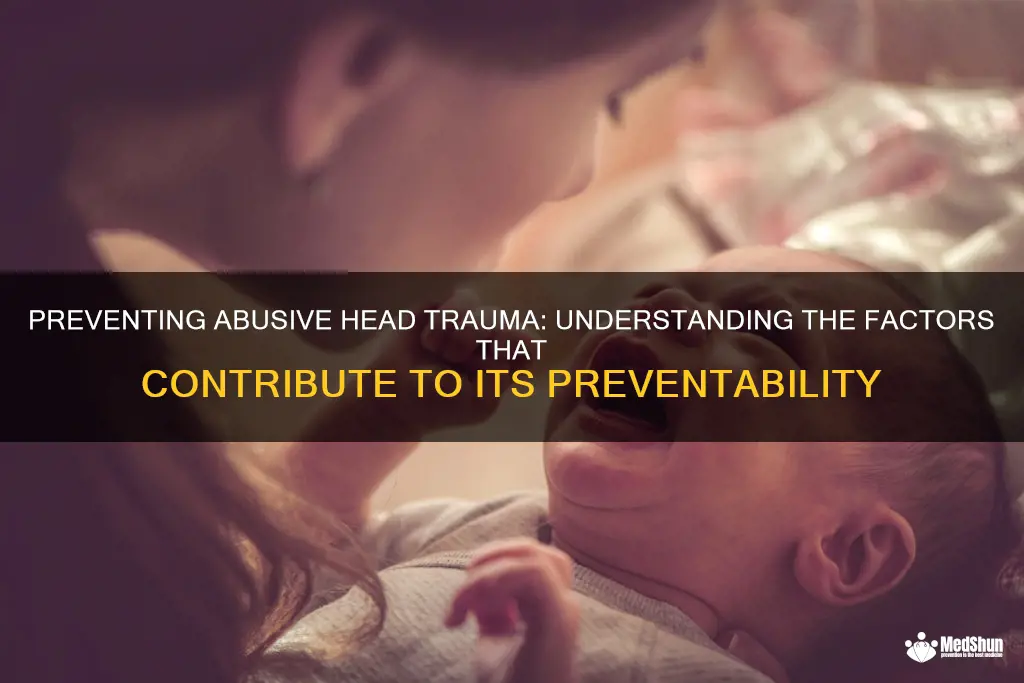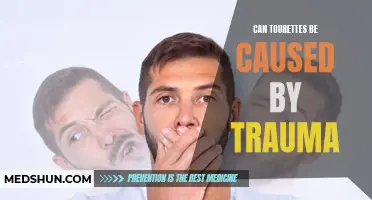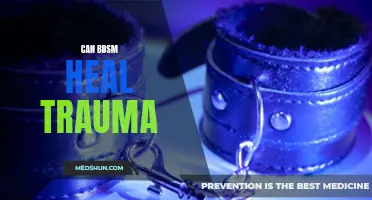
Abusive head trauma, commonly known as shaken baby syndrome, is a harrowing and devastating act of violence that causes severe injury or even death in infants and young children. The heartbreaking reality is that this type of trauma is entirely preventable. By understanding the signs of abusive head trauma and raising awareness about the dangers of shaking a baby, we can work together to protect the most vulnerable members of our society.
| Characteristics | Values |
|---|---|
| Shaking a baby vigorously | High |
| Impact to the head | High |
| Delayed medical attention | High |
| Lack of education about the dangers of shaking a baby | High |
| Presence of risk factors such as stress or substance abuse | High |
| Education about safe handling of infants | Low |
| Support networks for parents | Low |
| Access to counseling or mental health services | Low |
| Mandatory education for caregivers | Low |
| Safe sleeping environments for infants | Low |
What You'll Learn

Understanding the Causes of Abusive Head Trauma
Abusive head trauma, also known as shaken baby syndrome, is a devastating form of child abuse that can have lifelong consequences. It occurs when a baby or young child is violently shaken, resulting in severe brain damage or even death. This form of abuse is preventable, but in order to prevent it, it is important to understand its causes.
- Lack of understanding: One of the primary causes of abusive head trauma is a lack of understanding about the fragility of a baby's brain. Many caregivers may not realize the potential harm that can be caused by shaking a baby. It is crucial to educate parents, caregivers, and the general public about the dangers of shaking a baby and the consequences it can have.
- Stress and frustration: Another common cause of abusive head trauma is stress and frustration. Caring for a baby or young child can be extremely challenging, especially for parents who may be dealing with other stressors in their lives. It is important for parents and caregivers to have access to support and resources to help manage stress and frustration and to safely cope with these emotions without resorting to violence.
- Lack of coping skills: Some parents or caregivers may not have the necessary coping skills to handle the demands of caring for a baby. They may not have been taught healthy ways to manage stress or may not have had positive role models in their own lives. Providing parenting education and support can help parents develop the skills they need to care for their child in a safe and nurturing way.
- Substance abuse: Substance abuse is another factor that can contribute to abusive head trauma. Parents or caregivers who are under the influence of drugs or alcohol may be more likely to lose control and violently shake a baby. Addressing substance abuse issues and providing resources for treatment can help prevent this form of child abuse.
- Lack of support: Some parents or caregivers may feel overwhelmed and isolated, lacking the necessary support network to help them navigate the challenges of parenting. It is important for communities to provide support systems, such as parenting classes, support groups, and home visiting programs, to ensure that parents have the resources they need to provide a safe and nurturing environment for their child.
In conclusion, abusive head trauma is a preventable form of child abuse. By addressing the underlying causes of this type of abuse, such as a lack of understanding, stress and frustration, lack of coping skills, substance abuse, and lack of support, we can work towards preventing this devastating form of abuse. Education, support, and resources are key in ensuring the well-being of our children and promoting a safe and nurturing environment for all.
How Trauma Can Alter Your Personality
You may want to see also

Recognizing the Warning Signs and Risk Factors
Abusive head trauma, also known as shaken baby syndrome, is a preventable form of child abuse that can have devastating consequences. It occurs when a caregiver shakes a baby or young child forcefully enough to cause injury to the brain. The effects can be severe, leading to brain damage, developmental delays, and even death.
One of the key warning signs of abusive head trauma is unexplained or unusual injuries. If a child has unexplained bruises, cuts, or injuries that cannot be easily explained, it may be a red flag for abuse. Pay close attention to injuries that are inconsistent with the child's age and developmental stage, as well as injuries that are unlikely to have been caused accidentally.
Another important warning sign is a sudden change in behavior. If a child is normally happy, active, and engaged, but suddenly becomes withdrawn, irritable, or lethargic, it could be a sign of abuse. Changes in eating and sleeping patterns, as well as frequent crying or fussiness, can also be indicators of abusive head trauma.
Risk factors for abusive head trauma include a caregiver with a history of violent behavior, substance abuse, or mental health issues. Stressful situations, such as financial difficulties or social isolation, can also increase the risk of abusive behavior. Additionally, young parents or caregivers who lack knowledge or skills in baby care may be more likely to resort to shaking a child out of frustration or inexperience.
To prevent abusive head trauma, it is essential to educate parents, caregivers, and the community about the dangers of shaking a baby. Providing information about infant crying patterns, the importance of self-care for parents, and coping strategies for managing stress can help reduce the likelihood of abusive behavior.
Encouraging the use of positive parenting techniques is another important preventative measure. Teaching parents and caregivers effective ways to soothe and bond with their children can help reduce frustration and prevent the use of harmful methods like shaking.
Finally, it is crucial to establish a supportive network for parents and caregivers. This can include connecting them with community resources, such as parenting classes and support groups, as well as offering counseling or therapy for those struggling with mental health issues or substance abuse. Providing accessible and affordable child care options can also help alleviate stress and reduce the risk of abusive behavior.
In conclusion, recognizing the warning signs and risk factors of abusive head trauma is key to its prevention. By being vigilant, educating parents and caregivers, and offering support, we can work towards protecting our children and creating a safer, more nurturing environment for all. Remember, if you suspect a child may be a victim of abuse, it is important to report your concerns to the appropriate authorities immediately.
Understanding the Basics: What is Ortho Trauma?
You may want to see also

Preventing Abusive Head Trauma through Education and Awareness
Abusive head trauma, also known as shaken baby syndrome, is a devastating form of child abuse that can have lifelong consequences. It occurs when a caregiver violently shakes or hits a baby or young child, causing severe brain injury. The good news is that abusive head trauma is entirely preventable, and by increasing education and awareness, we can help protect our most vulnerable children.
Understand the signs and symptoms
One of the key ways to prevent abusive head trauma is to recognize the signs and symptoms. Babies and young children may exhibit symptoms such as vomiting, lethargy, irritability, difficulty breathing, and seizures. If you notice any of these signs, seek medical attention immediately. By understanding the symptoms, you can act quickly and potentially prevent further harm to the child.
Promote healthy coping mechanisms
Stress is a major trigger for abusive head trauma. It is essential to provide caregivers with healthy coping mechanisms to manage stress effectively. Encourage caregivers to engage in self-care activities such as exercise, meditation, or seeking support from family and friends. By promoting healthy coping mechanisms, we can help reduce the risk of abusive head trauma.
Educate caregivers about infant crying
Infant crying is a normal part of development, but it can be frustrating for caregivers, especially when they are already stressed. It is crucial to educate caregivers about normal infant crying patterns and help them understand that crying is not a reflection of their caregiving abilities. By teaching caregivers about the normalcy of crying and providing strategies for soothing techniques, we can reduce the likelihood of a caregiver becoming overwhelmed and resorting to abusive actions.
Provide parenting education and support
Many cases of abusive head trauma occur due to a lack of knowledge about child development and appropriate parenting techniques. By providing comprehensive parenting education and support, we can empower caregivers with the skills and knowledge they need to provide safe and nurturing environments for their children. Parenting classes can cover topics such as child development stages, discipline techniques, and stress management. By investing in parenting education and support programs, we are taking proactive steps towards preventing abusive head trauma.
Raise community awareness
Community awareness is crucial in preventing abusive head trauma. By raising awareness through public campaigns, educational programs, and social media, we can reach a broader audience and foster a culture of zero tolerance towards child abuse. Awareness campaigns can focus on educating community members about the signs and symptoms of abusive head trauma, providing resources for support, and promoting healthy parenting practices. By involving community organizations, schools, healthcare providers, and law enforcement agencies, we can create a united front against abusive head trauma.
Provide resources for caregivers
Caregivers need access to resources and support systems to help them navigate the challenges of parenting effectively. By connecting caregivers with community resources such as parenting hotlines, support groups, and counseling services, we can provide them with the help they need to prevent abusive head trauma. It is essential to ensure that these resources are readily available and easily accessible to all caregivers.
In conclusion, preventing abusive head trauma requires a multifaceted approach that includes education, support, and community involvement. By understanding the signs and symptoms, promoting healthy coping mechanisms, educating caregivers about infant crying, providing parenting education and support, raising community awareness, and offering resources, we are taking vital steps towards preventing this devastating form of child abuse. Together, we can create a safer world for our children.
Understanding the Trauma Behind Panda Eyes: Causes, Symptoms, and Treatments
You may want to see also

Implementing Effective Strategies to Reduce the Incidence of Abusive Head Trauma
Abusive head trauma, also known as shaken baby syndrome, is a preventable form of child abuse that can have devastating consequences. In order to reduce the incidence of this tragic condition, it is important to implement effective strategies that target both prevention and early intervention. By raising awareness, providing education, and offering support to families, we can work towards protecting children and ensuring their safety.
One important strategy for preventing abusive head trauma is to raise awareness about the dangers of shaking a baby. Many caregivers may not be aware that shaking a baby can cause serious brain injury, and it is crucial to educate them about the risks. This can be done through public awareness campaigns, educational materials, and training programs for parents, caregivers, and healthcare professionals. By ensuring that everyone understands the potential harm caused by shaking a baby, we can help prevent cases of abusive head trauma.
Education is another key component in reducing the incidence of abusive head trauma. By providing information about safe infant care practices, stress management, and coping mechanisms, we can equip parents and caregivers with the knowledge and skills necessary to care for their children without resorting to abuse. It is important to emphasize alternatives to shaking, such as techniques for soothing a crying baby or seeking support from friends, family, or community resources. By empowering parents and caregivers with non-violent parenting strategies, we can help prevent abusive head trauma.
Support for families is also essential in preventing abusive head trauma. Many cases of abusive head trauma occur when parents or caregivers are overwhelmed with stress and lack the necessary support systems. By providing access to support groups, counseling services, and community resources, we can help families navigate the challenges of parenthood and reduce the risk of abusive behavior. It is important to create a safe and supportive environment where parents feel comfortable seeking help and are aware of the resources available to them.
Early intervention is crucial in preventing recurrent cases of abusive head trauma. Children who have already experienced abusive head trauma are at higher risk for future episodes, and it is important to identify these cases as early as possible. Healthcare professionals play a crucial role in identifying signs of abuse, providing appropriate medical care, and connecting families with the necessary support services. By working together with healthcare professionals, child welfare agencies, and community organizations, we can ensure that children at risk receive the intervention and support they need to prevent further episodes of abusive head trauma.
In conclusion, implementing effective strategies to reduce the incidence of abusive head trauma requires a multi-faceted approach. By raising awareness, providing education, offering support, and intervening early, we can work towards preventing this preventable form of child abuse. It is our collective responsibility to protect the well-being of children and create a safe and nurturing environment for them to thrive.
Understanding the Core Principles of Trauma: The Three E's Approach
You may want to see also
Frequently asked questions
Abusive head trauma is highly preventable. It is often a result of shaking or hitting a baby or young child. Education and awareness campaigns about the dangers of shaking or hitting a child can help prevent this type of trauma. Additionally, teaching parents and caregivers positive parenting techniques and stress management skills can also decrease the likelihood of abusive head trauma occurring.
Some strategies to prevent abusive head trauma include promoting safe sleep practices for babies, avoiding shaking or hitting a child, teaching positive parenting techniques, providing support and resources for parents and caregivers, and raising awareness about the signs and consequences of abusive head trauma.
Yes, education plays a critical role in preventing abusive head trauma. By educating parents, caregivers, and the community about the dangers of shaking or hitting a child, as well as teaching them positive parenting techniques and stress management skills, the likelihood of abusive head trauma can be significantly reduced. Education can help change attitudes and behaviors, leading to safer and healthier environments for children.
Yes, there are several interventions and programs focused on preventing abusive head trauma. Some examples include the Period of Purple Crying program, which educates parents about normal infant crying and the risks of shaking, and the Safe to Sleep campaign, which promotes safe sleep practices to reduce the risk of Sudden Infant Death Syndrome (SIDS) and abusive head trauma. Additionally, many community organizations and child advocacy groups offer parenting classes and support services to help prevent abusive head trauma.







